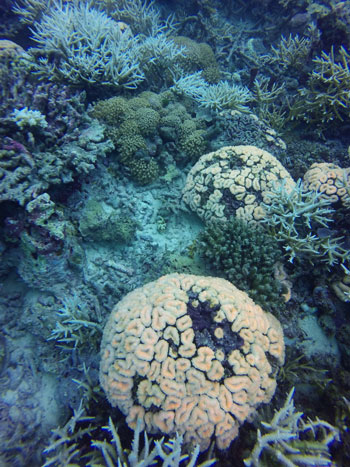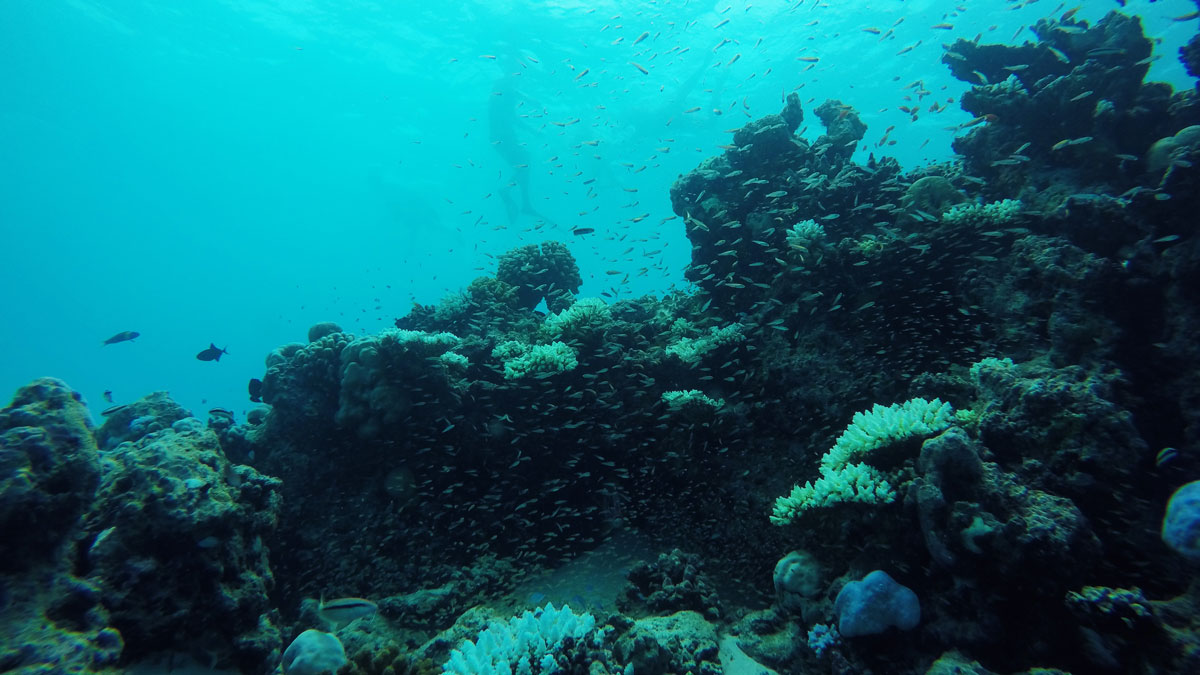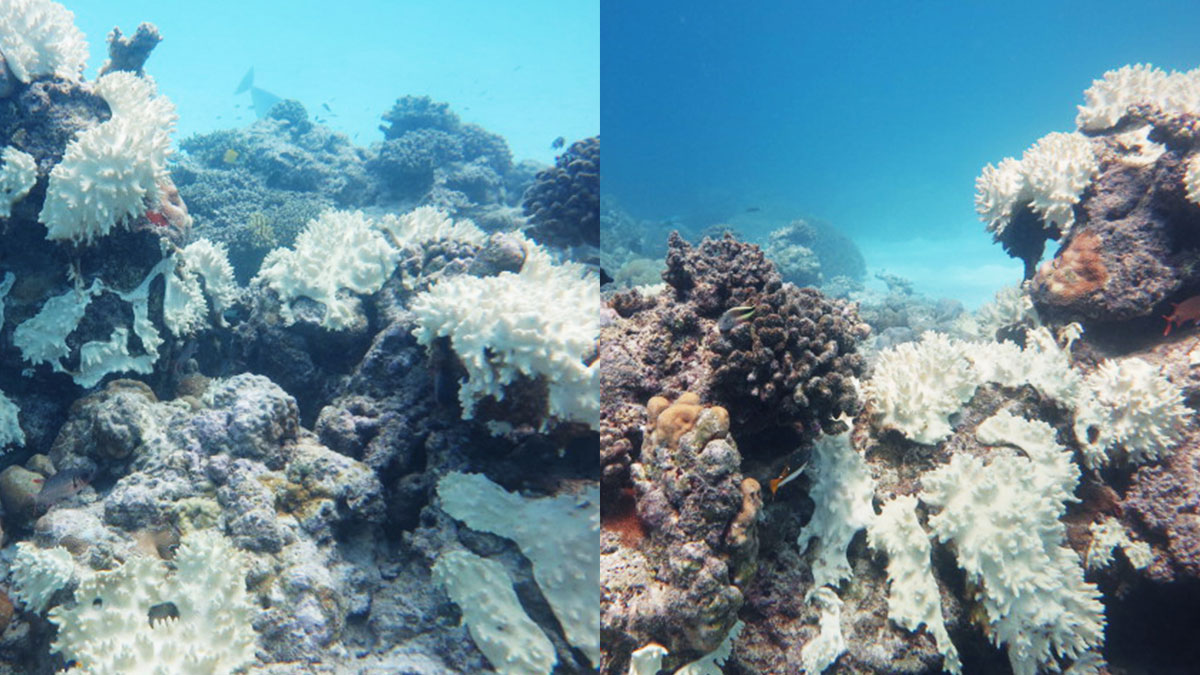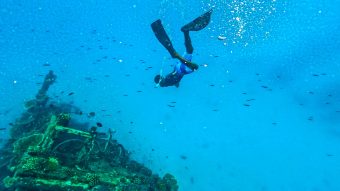
The dying reefs: Can resorts be their savior?
[vc_row][vc_column][vc_column_text]
Preliminary findings of a comprehensive scientific survey examining the impact of the climate change-related 2016 mass bleaching in the Maldives indicate approximately 60% of all coral colonies assessed – and up to 90% in some sites – were bleached.
[/vc_column_text][vc_separator][vc_column_text] A Survey conducted by the the Maldives Marine Research Center (MRC) and the Environmental Protection Agency (EPA), in partnership with the International Union for Conservation of Nature (IUCN) has revealed that 60% of Maldivian coral reefs have been bleached due to the recent surge in sea surface water temperatures.
A Survey conducted by the the Maldives Marine Research Center (MRC) and the Environmental Protection Agency (EPA), in partnership with the International Union for Conservation of Nature (IUCN) has revealed that 60% of Maldivian coral reefs have been bleached due to the recent surge in sea surface water temperatures.
The survey brought together experts from 11 national and international institutions and universities to assess the impact of the mass bleaching on coral reefs in the Maldives after higher than average sea surface water temperatures, linked to an El Niño Southern Oscillation Event, and caused mass coral bleaching around the world in 2016.
Dr. Ameer Abdulla, research team leader and Senior Advisor to IUCN on Marine Biodiversity and Conservation Science said, “Our survey was undertaken at the height of the 2016 event and preliminary findings of the extent of the bleaching are alarming, with initial coral mortality already observed. We are expecting this mortality to increase if bleached corals are unable to recover.”
The Maldives contains approximately 3% of global coral reefs and is one of the most vulnerable countries to climate change impacts given its mean land height of 1.5m.
Funded by the U.S. Agency for International Development (USAID), the survey was undertaken in Alifu Alifu Atholhu (North Ari Atoll), a representative atoll of the Maldives.
It examined both inhabited and uninhabited coral reef islands in sheltered and exposed locations. The main purpose of the survey was to document extent and severity of bleaching in Maldives as a result of unusually high temperature exposure and local human stressors, using Alifu Alifu as a case study.
“This survey was a key component of the Government´s Bleaching Response Plan,” said Dr. Shiham Adam, the Director General of the MRC. “It has provided us with unique insight into the effects of this coral bleaching event, and helped us understand the implications of climate change for our nation.
“Understanding the pattern and impacts of bleaching in Maldives will help us guide local management of highly vulnerable sites.”
Following the publication of the survey results, Hotelier Maldives spoke to a number of resort properties across the country to further understand the impact of the bleaching event in key areas of the Maldivian coral chain.
In the northern most Haa Alif atoll, Resident Marine Biologist at JA Manafaru, Stacy Mallaby noted that the bleaching was first noticeable during the beginning of April 2016. She said, “But in the following 2-3 weeks it got worse, much much worse.”
Mallaby observed that, depending on the depth of the reef, the event had deeply impacted on the reefs in Haa Alifu. Coral species that have suffered more and shown higher rates of mortality would be branching and table species (i.e. Acropora, Pocillopora and Stylophora), Galaxea, and some Goniopora colonies.
She said that in Haa Alif atoll, colonies that did survive the bleaching where then attacked by invasion of Drupella and (despite my efforts at removing them) some colonies have died following this invasion. An Acroporid table colony in particular was dead covered in algae in about a week after the first Drupella were seen on it.
“Porites colonies have coped better with some not bleaching at all and other only bleaching in areas directly facing the water surface – this is also true for Goniopora species, mainly Goniopora djiboutensis I believe. Those showing the best recovery would most definitely be Porites, Goniopora, and Diploastrea colonies.”
Noting reefs that were most impacted around the area, Mallaby said Huvahandhoo reef which has a maximum depth of 3 meters at best suffered greatly with much of the reef now dead. In contrast, Gallandhoo reef with a maximum depth of around 7 meters on the reef flat and probably closer to 10 meters at the crest experienced high levels of bleaching too.
In her opinion, “Gallandhoo reef however is ocean facing whereas Huvahandhoo reef faces into the atoll which may mean that Gallandhoo experiences more upwelling of colder water. Recovery at Gallandhoo has also been much higher than at Huvahandhoo.”
This difference in the reef conditions of the outer ridges of the atoll and inner reefs of the atolls were also observed in the central atolls of Maldives. In central Raa Atoll, Resident Marine Biologist at Adhaaran Select Meedhupparu, Georgina Reeves, noted that the topography of the atoll has deeper reefs on the outer islands while shallower reefs in the inner islands showed significantly more bleaching.
Reeves noted that the events which started unfolding in April effected the corals in the inner reefs more with over 75% of the corals in the reefs completely bleached.
Her observations were thoroughly backed by the dive instructors in the area, with Theo Christ, Base leader at Dive Point Meedhupparu, noting that the more susceptible coral species are completely dead in the inner reefs.
He noted that the larger coral species such as brain corals have started recovering and showed more resilience to the bleaching event, although some of the more vulnerable branching corals have also started recovering.
Ahmed Mujthaba, Dive Instructor at Dive Club Furaveri Island Resort and Spa in Raa Atoll, also noted the alarming sea temperatures that effected the coral reefs. He said, “April and May saw the warmest sea temperatures in his 20 year diving career”. He said that the sea temperatures even at 30 meters deep rose to 31 Degrees Celsius, where temperatures usually go to 29 Degrees Celsius even during the warmest of months.
In the south of the country, Oscar Ignetik, Resident Marine Biologist at Sixe Senses Laamu, noted that the coral reefs around Six Senses and Laamu atoll as a whole have been devastated by the recent bleaching event, and in some cases 80% + of reefs inside the atoll have perished.
He said specifically, “Acropora corals have literally been wiped out. We first started to notice the bleaching around April and within the next 30 days we went through the bleaching phases to algae covered coral.”
Six Senses Laamu is currently conducting a study on the recovery rate of specific genera’s of coral and general coral reef health and noted that they were yet to see new coral larval settlement.
To coordinate a national response to the phenomenon and provide guidance to reef users on how to manage the impact, the Maldives government has created the National Bleaching Task Force. Led by the MRC, the Task Force includes the Environmental Protection Agency and is supported by IUCN.
A national monitoring program has also been developed by MRC and IUCN to evaluate recovery of reefs across the country. The program enables resort marine biologists, citizen scientists, and divers across the Maldives to contribute data that will help understand the national effects of the global bleaching event.
With the coral reefs undoubtedly being the greatest asset of the Maldives, especially the tourism sector, many resorts already have mitigation and regeneration programs in place. A special focus on educating guests and divers on the conditions of the reefs have also been put in place at many resorts.
This can be a tricky job though, as Georgina Reeves at Adhaaran Meedhupparu noted. “Guests often get confused when identifying dead and living corals. As a marine biologist I’m obliged to educated them, but at the same time, they are paying for these amazing underwater experiences, so its difficult to ruin their experience by telling them all the corals they just saw was dead.”
Stacy Mallaby at JA Manafaru also noted that, “Many guests did not pay any attention to the bleaching at all and still thought the reef was beautiful. Those that did ask I explained bleaching and bleaching events in global terms so they would understand not only what was happening, why it was happening but that it was happening all over the world. I also speak about this in weekly coral reef presentations and gives me an opportunity to go more in-depth with guests that attend as they are more interested.”
Ahmed Mujthaba at Dive Club Furaveri noted that the effects of the bleaching is so fast that its takes almost three days for a coral to be completely bleached and algae grows back on them within a weeks’ time, thus, guests are usually oblivious to what they actually see.
Oscar Ignetik at Six Senses Laamu also shared the same sentiments, noting that, “most guests would not actually have a clue about the recent bleaching event as they dont know anything about it; most guests still come out of the water and are speechless with how beautiful it is. On the other hand guests who are aware of the coral bleaching are generally quite disappointed.”
Naeem Ibrahim, Director General of the Environmental Protection Agency noted that “Local management actions can build the resilience of coral reefs thus helping them to survive this national bleaching event.”
One of the flagship programs to mitigate the effects and rejuvenate the coral reefs following the El Nino on 1998, include the Reefcapers project conducted by Seamarc, in various resorts of Maldives.
The project sees propagation using coral frames made of welded and coated iron bars and now rank as some of the most successful in the world. To date they have transplanted more than 3000 coral frames (covering 2 hectares) using over 40 species of corals.
These frames, sponsored by guests can be found at Four Seaons Resort Maldives at Landaa Giraavaru and Kuda Huraa, One and Only Reethi Rah, Club Med Kani, Cocoa Island by Como, Kanuhura and Reethi Beach Resort.
A number of other properties across the country also conduct similar projects of coral rejuvenation, including Coco Palm Dhunikolhu, Coco Bodu Hithi, Kurumba Maldives, Baros Maldives, The Beach House at Iruveli Maldives, Taj Exotica Resort and Spa & Ocean Dive Maldives, Anantara Kihavah, Maldives, The Residence Maldives on Falhumaafushi, Outrigger Konotta Resort, PER AQUUM Huvfen Fushi, Cheval Blanc Randheli, Conrad Maldives Rangali Island, Holiday Inn Resort Kandooma Maldives and Jumeirah Vitavelli among many others.
Apart from these projects, reported data are currently being analysed by the task force, in order to strategically identify vulnerable and resilient reefs across the country that should be managed or protected.[/vc_column_text][/vc_column][/vc_row]








